|
|
NEOLITHIC BEADS: ECHOES FROM AN ANCIENT TIME
Our journey takes us to the fascinating world of Neolithic stone
beads that have been unearthed from ancient settlements in the Moroccan
Sahara, dating back to around 5000 BC and lasting until approximately
1200 AD. These relics not only hold aesthetic appeal but also provide an
intriguing look into our past, and into a time when the Sahara was not
the vast desert we know today.
Around 3000 BC, the Sahara underwent a dramatic transformation from a
lush, green landscape filled with life, to the expansive, arid desert it
is today. However, this was not always the case. Prior to this
transformation, the Sahara experienced an extended wet period that can
be traced back to at least 8000 BC. It was during these wet periods that
the Sahara was home to Neolithic settlements, traces of which can still
be found scattered across the Moroccan Sahara today.
However, it's worth noting that determining the age of these beads is
often a complex process. The Neolithic period, defined by the advent of
farming and marked advancements in tool making, isn't time-bounded the
same way in Africa as it is in other regions of the world. Some could
argue that in certain parts of Africa, a form of Neolithic lifestyle
still persists, blurring the lines of historical demarcation.
In this context, the patina - the change in surface appearance due to
age and exposure - is often the most reliable indicator of a bead's age.
Moreover, the method of production, the Neolithic technique of bead
making, remained in use for an extended period, perhaps even persisting
in some remote areas to this day.
The 12th Century heralded significant changes in this regard. Arab
traders journeying to Africa brought with them advanced drilling tools
and techniques from India, enabling the creation of more sophisticated
beads. Furthermore, these traders didn't just bring new tools and
techniques; they also carried with them beads crafted in India.
In my travels through Morocco, I've encountered a multitude of these
ancient Indian beads, each with its own unique story to tell. This isn't
surprising, given that beads have always been significant cultural
objects and are often among the first items to be exchanged between
different cultures. Wherever there's evidence of cultural exchange, you
can almost be certain that beads were part of the interaction, acting as
diminutive ambassadors of their native cultures. Therefore, whether in
Africa or elsewhere, these Neolithic beads represent not just beautiful
objects of adornment, but also artifacts of historical and cultural
exchange.
|
The beads in
my collection
are now for sale
Inquire
through bead ID
for price
|
|
|
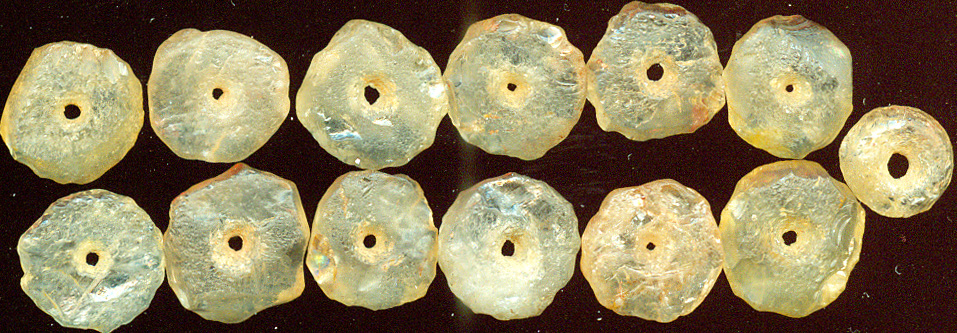
Wonderful citrin beads - 12 * 5 mm - SOLD
|
Observe the marked contrast between
the beads exhibited above and those displayed below, despite originating
from the same Neolithic settlements. The upper assortment appears more
rudimentary in shape and craftsmanship when compared to the more refined
ones presented beneath.
There's a plausible explanation for this contrast rooted in the
lifestyle of the communities these artifacts belong to. The societies in
the Sahara during the Neolithic period were primarily comprised of
hunter-gatherers, whose daily survival heavily relied on tools such as
axes, spears, and arrows. The production of these tools, vital for
hunting and defense, may not have necessitated the development of fine
polishing skills, evident in the relatively crude nature of the beads in
the upper display.
In contrast, the lower set of beads, exhibiting a higher degree of
polish and sophistication, are likely to be the product of more settled,
agricultural societies that were emerging during this period. These
communities had more stability and resources to dedicate to
craftsmanship, allowing for the creation of finer, more polished
objects.
There's a tantalizing possibility that these sophisticated beads found
their way to the hunter-gatherer societies of the Sahara through
interactions with these agricultural communities. This could have been
facilitated by contacts and exchanges, perhaps even early forms of
trade. Therefore, these finely crafted beads not only represent an
advancement in craftsmanship but also bear silent testimony to the
burgeoning connections between societies in the Neolithic period.
|
|
|
|
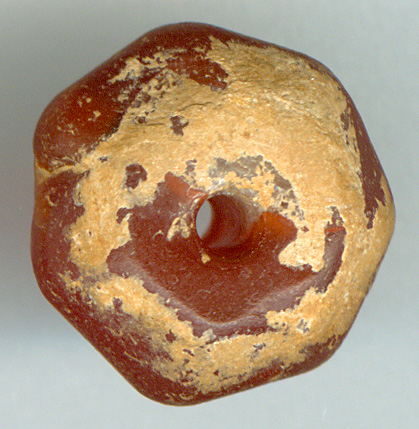
|
The bead featured above, discovered in a Neolithic
gravesite alongside a trove of more rudimentarily shaped
counterparts, serves as a fascinating example of such
cross-cultural exchanges. Standing out in its refinement
and design, it is an apparent outsider among its peers.
Its presence here, in a setting dominated by more
crudely formed pieces, is intriguing and points to the
interaction and exchange between the Sahara's
hunter-gatherer societies and more agriculturally
advanced cultures.
This unique bead acts like a silent storyteller,
offering tantalizing clues about the interactions,
exchanges, and possibly, the barter practices between
distinct cultures and societies during the Neolithic
era. This bead is more than just an aesthetic piece; it
is a tangible trace of ancient cultural connections and
early commerce.
You can explore more about the remarkable journey and
origin of this bead by
following the link provided.
|
|
|
|
|
Early
Indus Valley tabular disk beads
Indus Valley is known for its remarkable
legacy of bead craftsmanship, and one of the most iconic styles from
this ancient civilization is the tabular disk bead. These early beads
are unique for their telltale marks of pecking, despite subsequent
polishing on a grinding stone - a feature common in beads from the
Neolithic period.
When you look at the beads presented below, one of the most striking
attributes you'll notice is the consistent, high-quality deep red
carnelian. These gemstones, notable for their lush, fiery hues, are a
testament to the exquisite taste and craftsmanship of the Indus Valley
civilization.
Carnelian, a semi-precious gemstone, was highly prized in the ancient
world for its captivating, radiant color. The choice of this material
not only reflects the technical mastery and aesthetic sensibility of
Indus Valley artisans but also gives us a glimpse into the cultural and
symbolic values of this early civilization.
Indeed, these early Indus Valley tabular disk beads, with their finely
honed shapes and distinctive coloration, bear the indelible mark of a
culture that truly understood and appreciated the art of bead making.
|
|
|
|
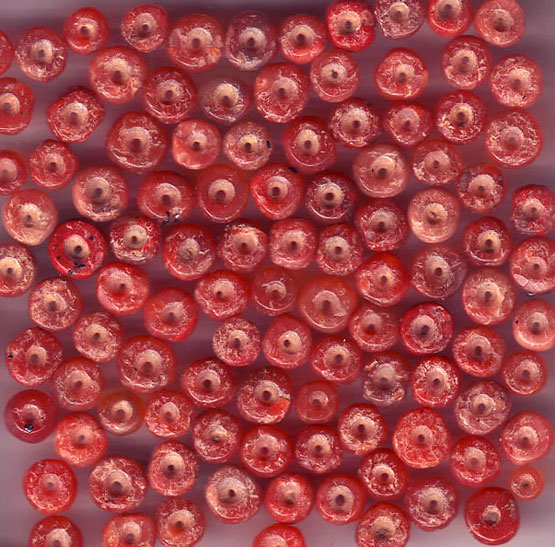
CARN
- OIV 3 -
Average size: 10 * 3 mm
Period:
Indus Valley Culture - Most probably the
Ravi Phase 3300-2800 BC
Origin: Harappa - Greater India (Now Pakistan)
The site
www.harappa.com, picture no.120
shows the same carnelian type of bead to the right.
Here is a photo from an excavation find from Bhirrana
where you can see the same disk beads.
(Archaeological Survey of India)
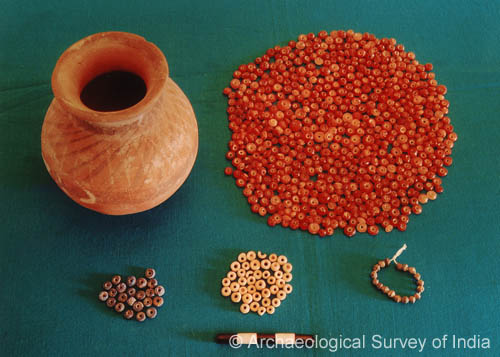
|
Below you can observe some of the more fine shaped beads in my Neolithic collection.
|
|
|
|
|
The drilling technique of Neolithic beads
The Neolithic beads were produced with the simplest tools! Here you can see the drills used for the pecking of the holes. The pecking was done from both sides of the bead.
|
|
|
|
|
Most beads from the Neolithic period are, as you can see on the picture below, not too long. They are
disk shaped.
|
|
|
|


|
|
The similarities between the beads discovered in
Neolithic graves in the Sahara and those originating
from the early Indus Valley are indeed remarkable. My
hypothesis is that these beads, often assumed to be the
creation of local Sahara cultures, may have been
produced by the more advanced Bronze Age civilizations
spanning from Persia to the Indus Valley.
These beads could have reached the Saharan region via
ancient trade routes, bringing with them the cultural
and artistic influences of their origins. They serve as
tangible pieces of evidence for early globalization,
revealing how objects of beauty and cultural
significance could cross vast geographical expanses,
even in ancient times.
A comparison of design elements, material choice, and
craftsmanship suggests a compelling connection between
these seemingly disparate regions. The refined shape,
skilled workmanship, and intricate detailing evident in
the Sahara beads echo the sophistication of beadwork
from the Indus Valley. Such intricate artistry was
characteristic of Bronze Age civilizations, underlining
the possibility of an intercultural exchange.
This theory could mean that a significant portion of the
beads found in Neolithic Saharan graves might not be
local artifacts but cultural imports from
technologically and artistically advanced civilizations
of that period. If this theory holds, it not only
reshapes our understanding of Neolithic Sahara but also
underscores the extensive reach of Bronze Age
civilizations like the Indus Valley.
However, further research, including metallurgical
analysis and isotopic studies, would be required to
confirm this hypothesis conclusively. These
investigative processes would help identify the material
origins of the beads, thereby validating or disproving
any links to external cultures.
|
|
|
|
|
|
|
|

Indus Valley Culture,
Ravi Phase 3300-2800 BC - 10 * 3 mm
|
When you look at the drills above it gives sense that the beads were mostly tabular. Drilling of long holes in long beads is very difficult and began with the Copper bronce age in West Asia and the Indus Valley. It became a goal in itself to make beads as
long and as slender as possible.
On the
Indus-sites we find a lot of broken beads that tells us that this kind of bead making was a difficult task to make elongated beads.
|
|
|
|
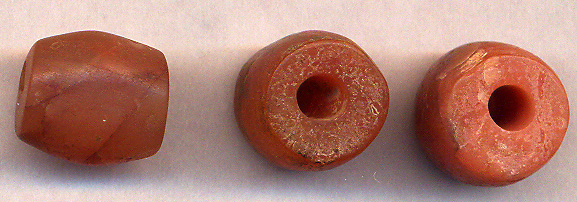
12 * 11 mm
|
In these more rare bi-conical carnelian beads, the pecking hole is uneven,
often taking shape like a hour glass as you can see below:
|
|
|
|
|
|
Here is a typical Neolithic hand grinding stone:
|
|
|
|
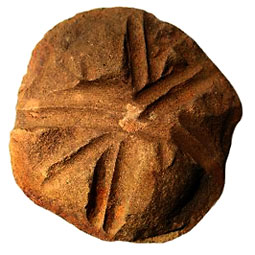
|
At that time all beads were hand grinded on these stones.
|
|
|
|
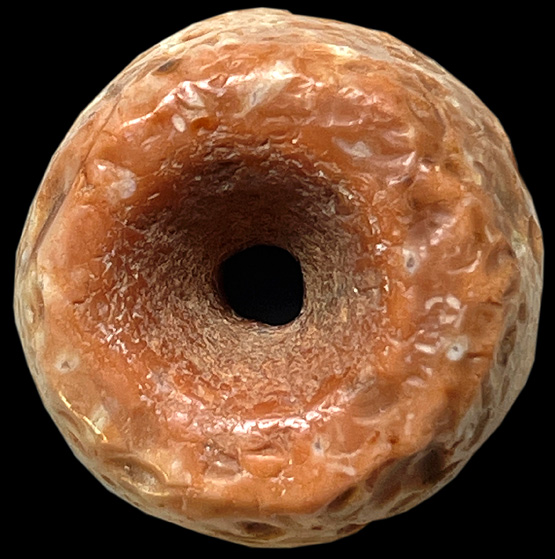
NEO 1 - 20,5 * 15 mm
|
|
|
|

NEO 2 - 18,5 * 7,5 mm
|
|
|
|

NEO 3 - 15,9 * 9,9 mm
|
|
|
|
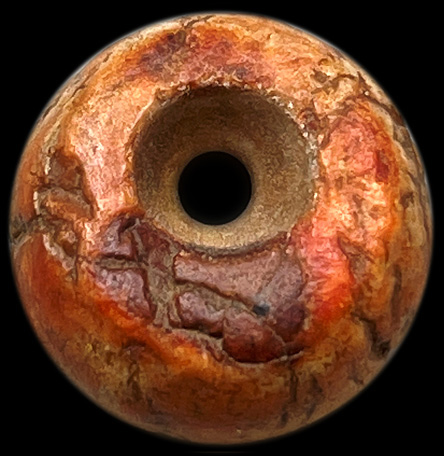
NEO 4 - 14,5 * 9,2 mm
|
|
|
|

NEO 5 - 17 * 16 * 8 mm
|
|
|
|

NEO 6 - 16,5 * 10 mm
|
|
|
|
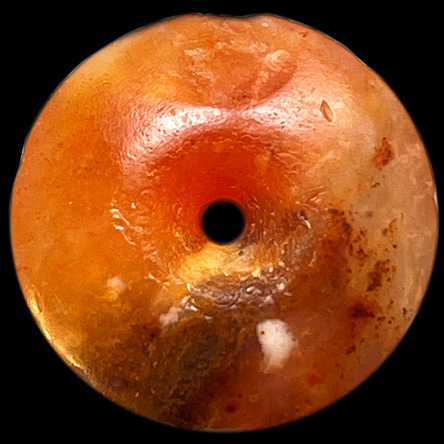
NEO 7 -
|
|
|
|

NEO 8 - 17 * 5 mm
|
|
|
|
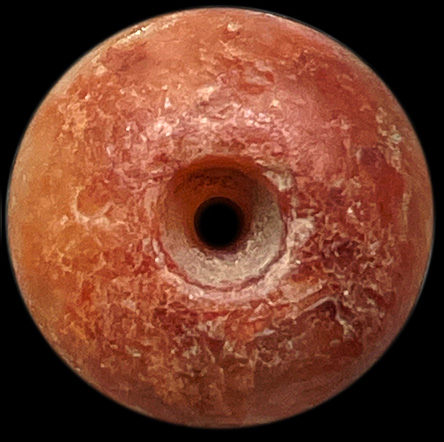
NEO 9 - 1,2 * 17,5 mm
|
|
|
|

NEO 10 - 21 * 10,5 mm
|
|
|
|
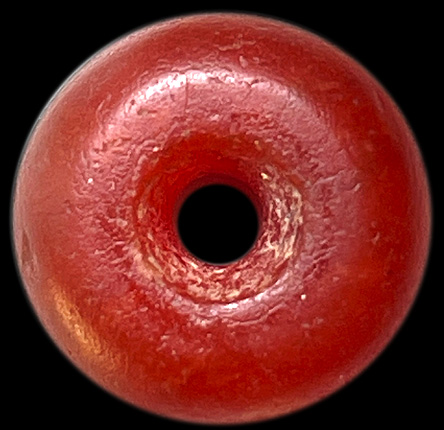
NEO 11 - 15 * 8 mm
|
|
|
|

NEO 12 - 14 * 6 mm
|
|
|
|

NEO 13 -
|
|
|
|

NEO 14 - 13,5 * 12 mm
|
|
|
|
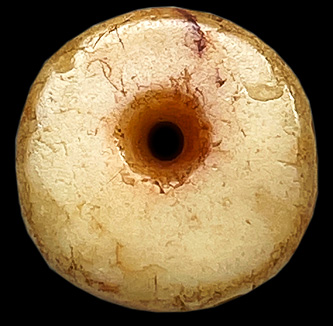
NEO 15 - 13,2 * 9 mm
|
|
|
|

NEO 16 - 13,9 * 7,9 mm
|
|
|
|

NEO 17 - 19 * 11,1 mm
|
|
|
|

NEO 18 - 21 * 7,5 mm
|
|
|
|
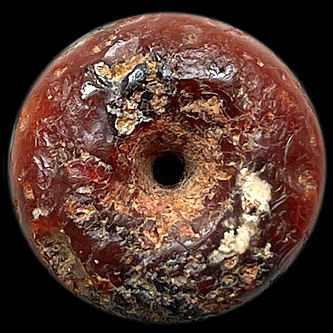
NEO 19 - 17 * 8,5 mm
|
|
|
|
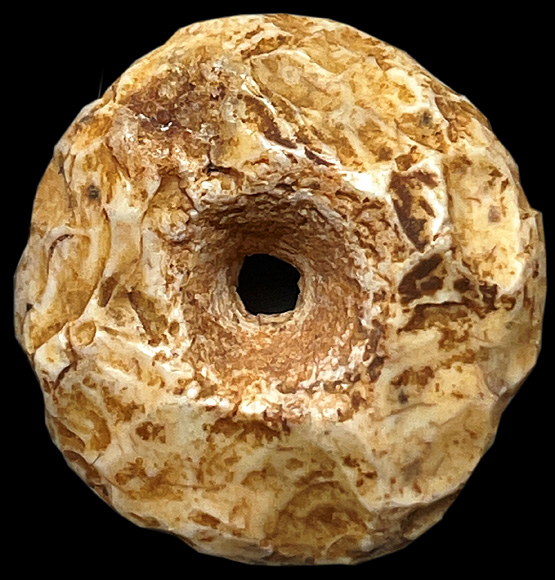
NEO 20 - 21 * 8,5 mm
|
|
|
|

NEO 21 - 22,3 * 12,5 mm
|
|
|
|

NEO 22 - 17,4 * 15 * 6,9 mm
|
|
|
|

NEO 23 - 18,2 * 6,1 mm
|
|
|
|

NEO 24 - 18,5 * 8,1 mm
|
|
|
|
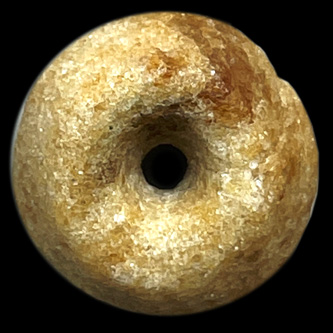
NEO 25 - 15 * 8 mm
|
|
|
|
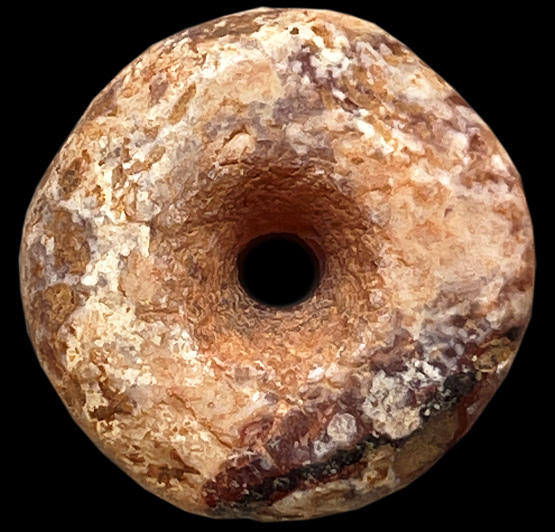
NEO 26 - 16,5 * 6,5 mm
|
|
|
|
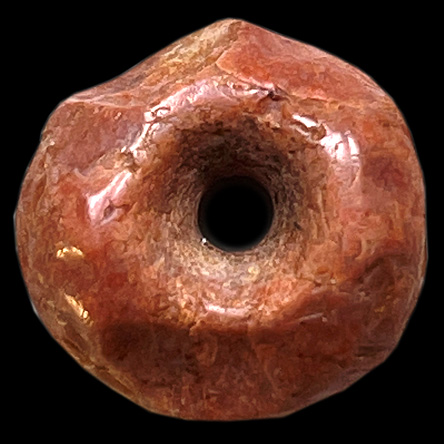
NEO 27 - 14,4/14 * 7,2 mm
|
|
|
|

NEO 28 - 16,1 * 6,9 mm
|
|
|
|

NEO 29 - 17,9 * 10,9 mm
|
|
|
|
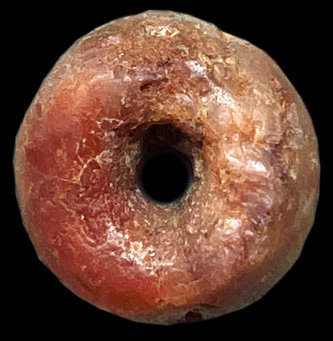
NEO 30 - 14,5 * 6,3 mm
|
|
|
|

NEO 31 - 15 * 6,2 mm
|
|
|
|

NEO 32 -
|
|
|
|
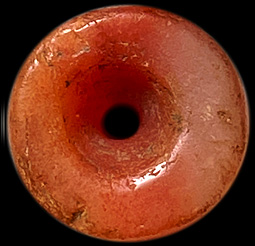 9 9
NEO 33 - 9,5 * 12 mm
|
|
|
|

NEO 34 - 15 * 8,5 mm
|
|
|
|

NEO 35 - 11,5 * 6,1 mm
|
|
|
|

NEO 36 - 15 * 9 mm
|
|
|
|

NEO 37 - 18,9 * 8,2 mm
|
|
|
|

NEO 38 - 12,9 * 4,8 mm
|
|
|
|

NEO 39 - 11,8 * 8,8 mm
|
|
|
|

NEO 40 - 15 * 5 mm
|
|
|
|

NEO 41 - 14,8 * 7 mm
|
|
|
|

NEO 42 - 15 * 9,5 mm
|
|
|
|
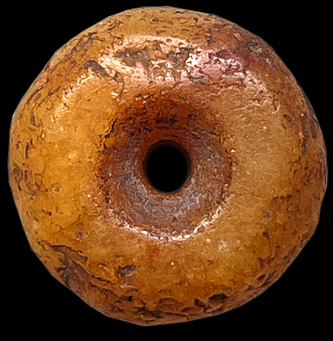
NEO 43 - 15,5 * 6,1 mm
|
|
|
|

NEO 44 - 17 * 10 mm
|
|
|
|
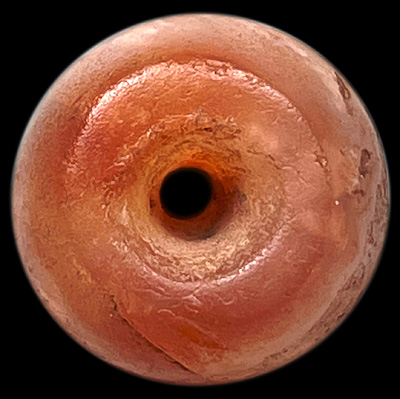 
NEO 45 - 14,5 * 13 mm
|
|
|
|
 
NEO 46 - 12,6 * 8 mm
|
|
|
|
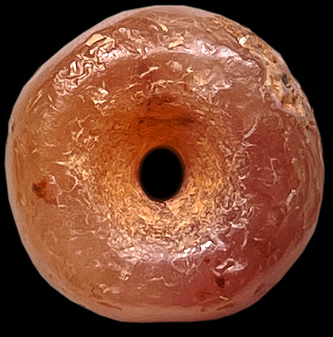 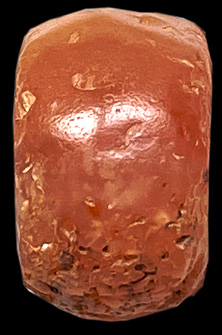
NEO 47 - 14,1 * 8,9 mm
|
|
|
|

NEO 48 - 16 *8 mm
|
|
|
|
NEO -
|
|
|
|


NEO 49 - 14,3 * 13,3 mm
|
|
|
|

NEO 50 - 15 * 11,5 mm
|
|
|
|

NEO 51 - 10,2 * 8,2 mm
|
|
|
|


NEO 52 - 13,5 * 9,8 mm
|
|
|
|


NEO 53 - left: 11 * 8 mm
|
|
|
|

NEO 54 - 14 * 10.5 mm
|
|
|
|

NEO 55 - 12,2 * 6 mm
|
|
|
|
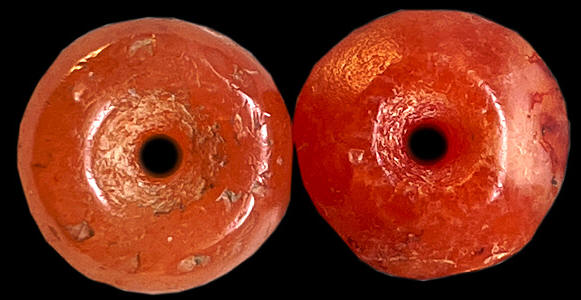
NEO 56 - left: 12,8 * 6,5 mm
|
|
|
|
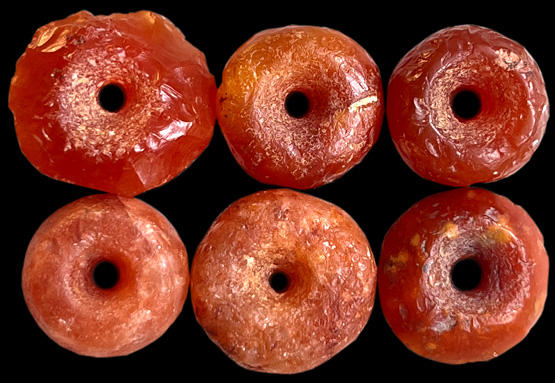
NEO 57 - upper left: 15 * 5,5 mm
|
|
|
|

NEO 58 - up: 12,2 * 6,1 mm
|
|
|
|

NEO 59 - low left: 14 * 7,2 mm
|
|
|
|
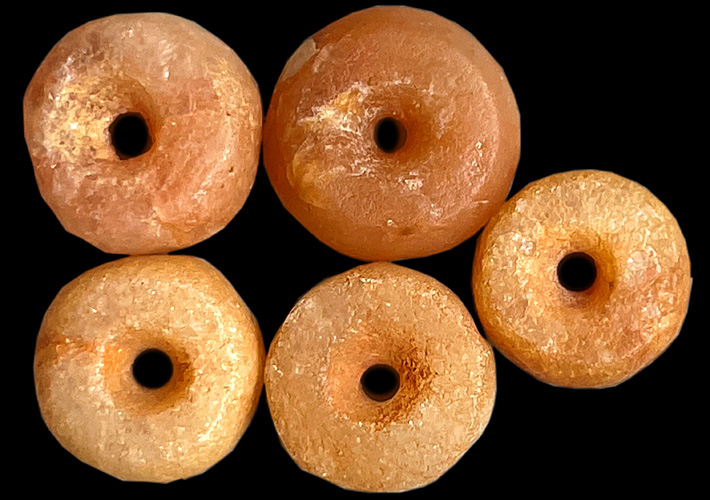
NEO 60 - low left: 11 * 5,6 mm
|
|
|
|

NEO 61 - low left: 15,1 * 7 mm
|
|
|
|

NEO 62 - 12;2 * 10 mm
|
|
|
|
NEO -
|
|
|
|
NEO -
|
|
|
|


NEO 63 - middle: 9,2 * 8,5 mm
|
|
|
|
 
NEO 64 - left: 13 * 6 - right: 12 * 8,5 mm
|
|
|
|

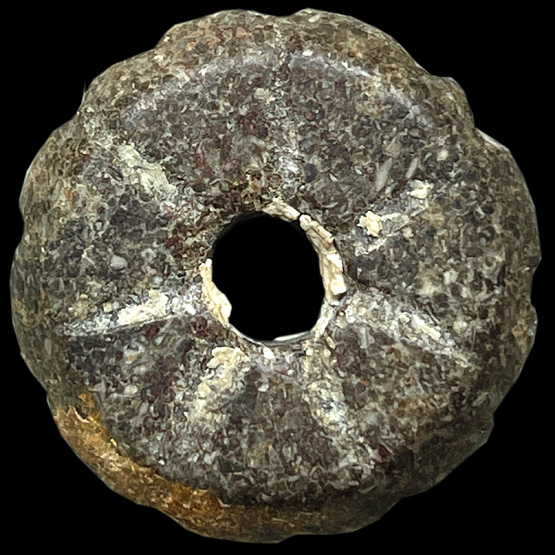
NEO 65 - 22 * 12 mm
|
|
|
|

NEO 66 - 22 * 19 * 6 mm
|
|
|
|
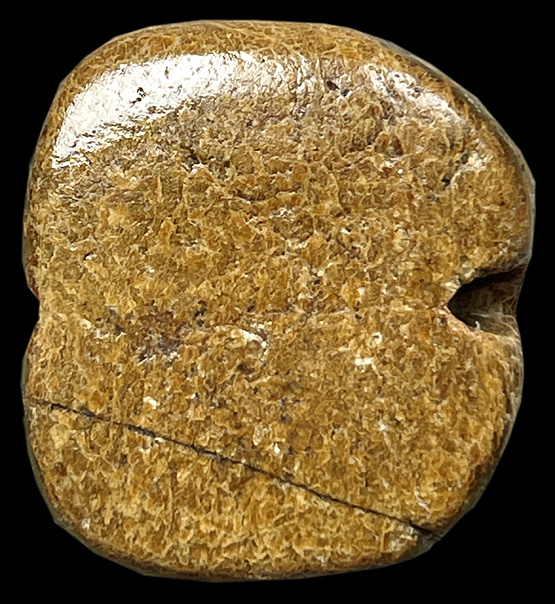
NEO 67 - 23,5 * 21 * 8 mm
|
|
|
|

NEO 68 - 20 * 11,5 mm
|
|
|
|

NEO 69 - 22,5 * 15 * 6 mm
|
|
|
|

NEO 70 - 21 * 15 * 13 mm
|
|
|
|
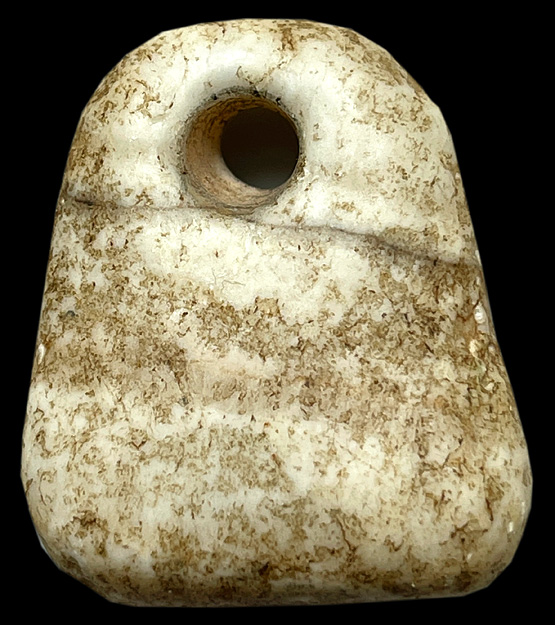
NEO 71 - 31 * 26,5 * 7 mm
|
|
|
|


NEO 72 - 14 * 14 mm
|
|
|
|
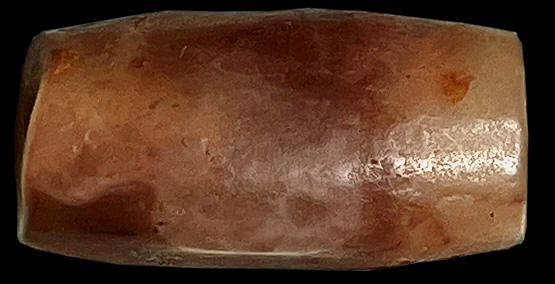
NEO 73 - 17 * 8,8 mm
|
|
|
|

NEO 74 - 28 * 20 mm
|
|
|
|

NEO 75 - 21 * 18,3 * 12,9 mm
|
|
|
|

NEO 76 - 21 * 4 mm
|
|
|
|

NEO 77 - 14 * 12 * 10 mm
|
|
|
|
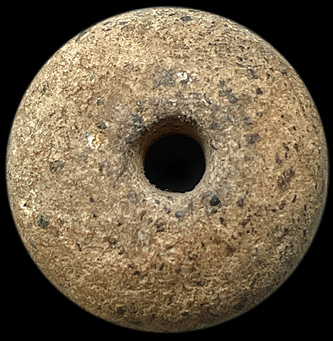
NEO 78 - 22,5 * 11,5 mm
|
|
|
|

NEO 79 - 33 * 18,5 * 11,6 mm
|
|
|
|

NEO 80 - 19,3 * 17 * 4,9 mm
|
|
|
|

NEO 81 - 25,2 *19,2 * 7,9 mm - SOLD
|
|
|
|
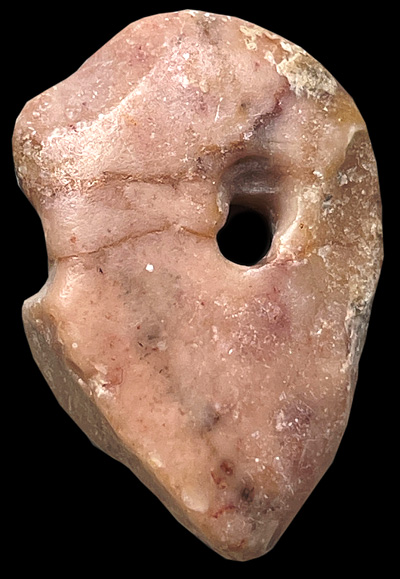
NEO 82 - 31 * 20,9 * 9,5 mm
|
|
|
|

NEO 83 - 18 * 5,9 mm
|
|
|
|

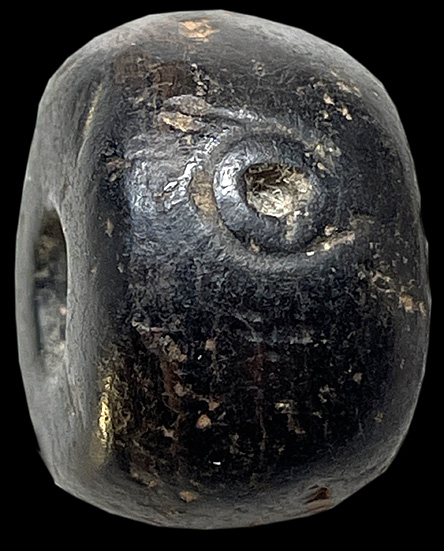
NEO 84 - 23 * 15,9 mm
|
|
|
|


NEO 85 - 26,1 * 18,9 mm
|
|
|
|
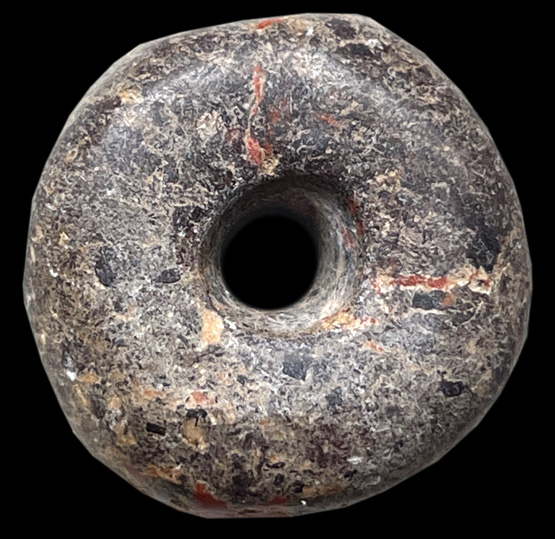
NEO 86 - 25 * 9,9 mm
|
|
|
|

NEO 87 - 17,1 * 5,3 mm
|
|
|
|

NEO 88 - 21,5/21 * 6,3 mm
|
|
|
|

NEO 89 - 19 * 11,9 mm
|
|
|
|

NEO 90 - 14,5 * 13,2 * 9 mm
|
|
|
|

NEO 91 - 13,9 * 8,5 mm
|
|
|
|

NEO 92 - 20 * 9 mm
|
|
|
|

NEO 93 - 13,5 * 13,2 mm
|
|
|
|
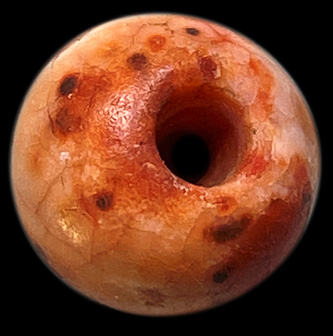
NEO 94 - 12,8 * 11,4 mm
|
|
|
|
NEO -
|
|
|
|
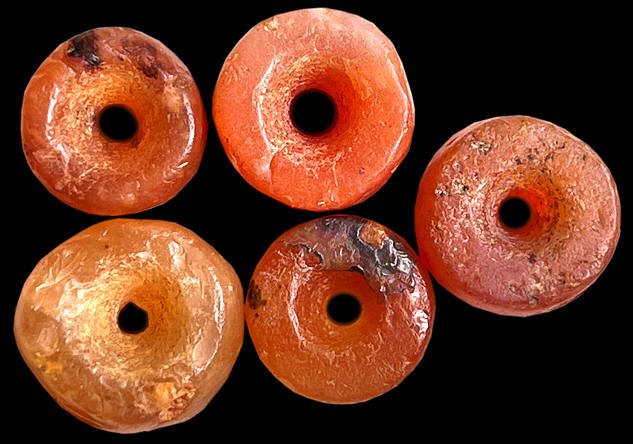
NEO 95 - left low: 12,2 * 9,1 mm
|
|
|
|

NEO 96 - left low: 14,6 * 8,2 mm
|
|
|
|
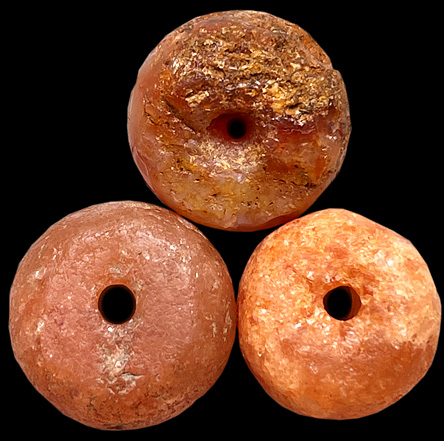
NEO 97 - Low left: 15,5 * 10,1 mm
|
|
|
|
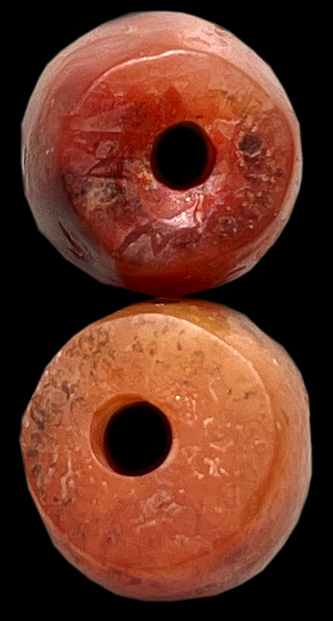 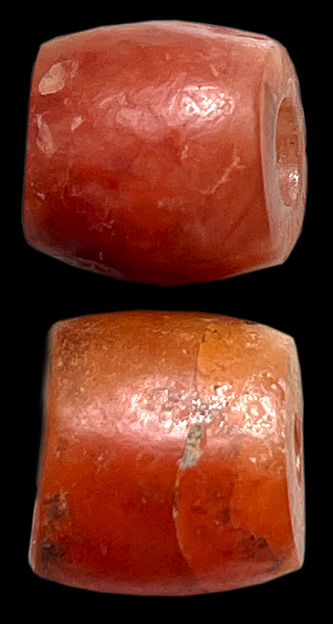
NEO 98 - Low: 12 * 11,8 mm
|
|
|
|
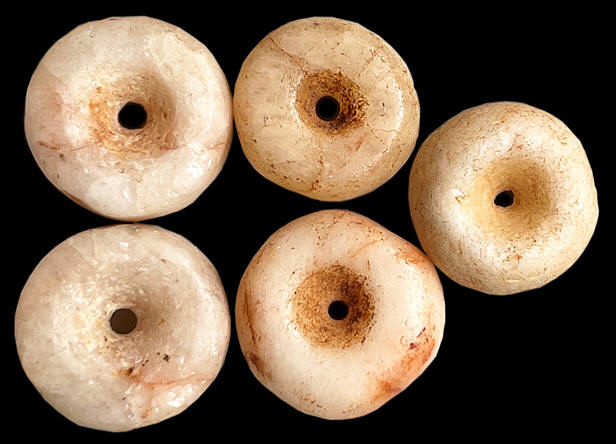
NEO 99 - Low left: 14,1 * 7,5 mm
|
|
|
|
 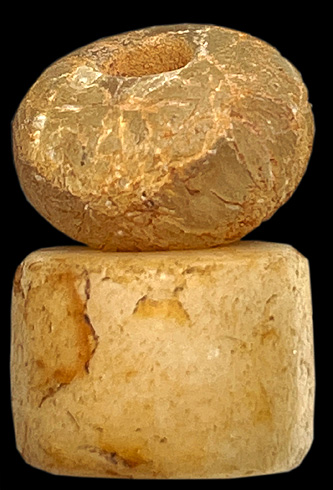
NEO 100 - low:14,1 * 10,5 mm
|
|
|
|

NEO 101 - left: 11,8 * 7,3 mm
|
|
|
|
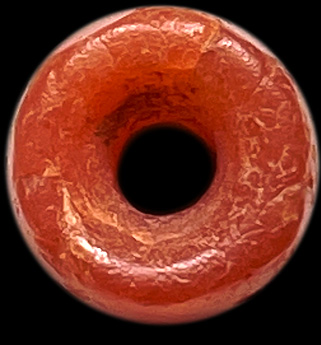 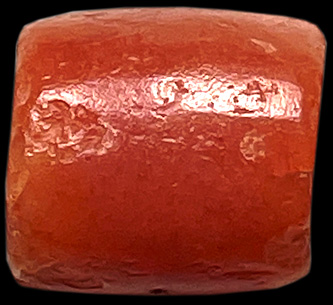
NEO 102 - 10,9 * 10,1 mm
|
|
|
|
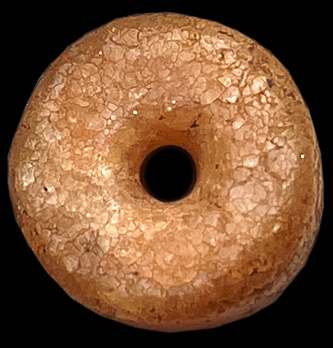
NEO
103 -
13,9 * 8,9 mm
|
|
|
|
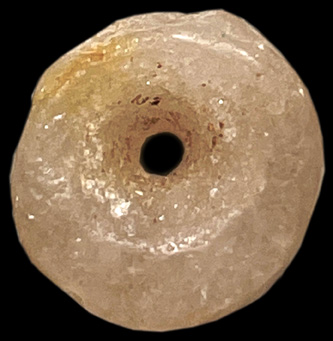
NEO
104 -
9 * 7,9 mm
|
|
|
|

NEO
105 -
8,4 * 8 mm
|
|
|
|
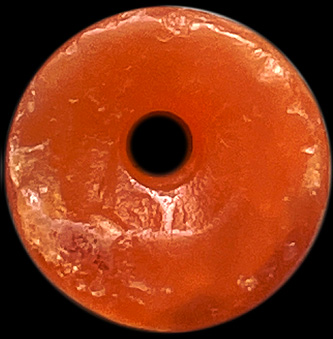
NEO
106 -
12,8 * 5,2 mm
|
|
|
|
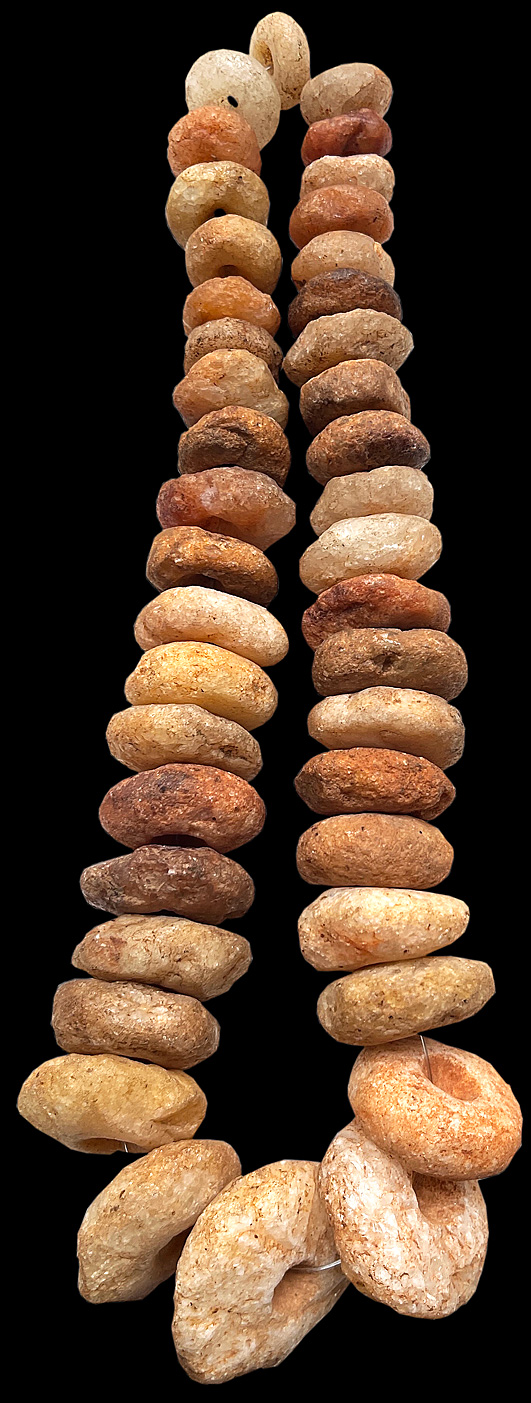
NEO
107 -
Largest bead: 34 * 11 mm
|
|
|
|
NEO -
|
|
|
|
NEO -
|
|
|
|
|
|
|